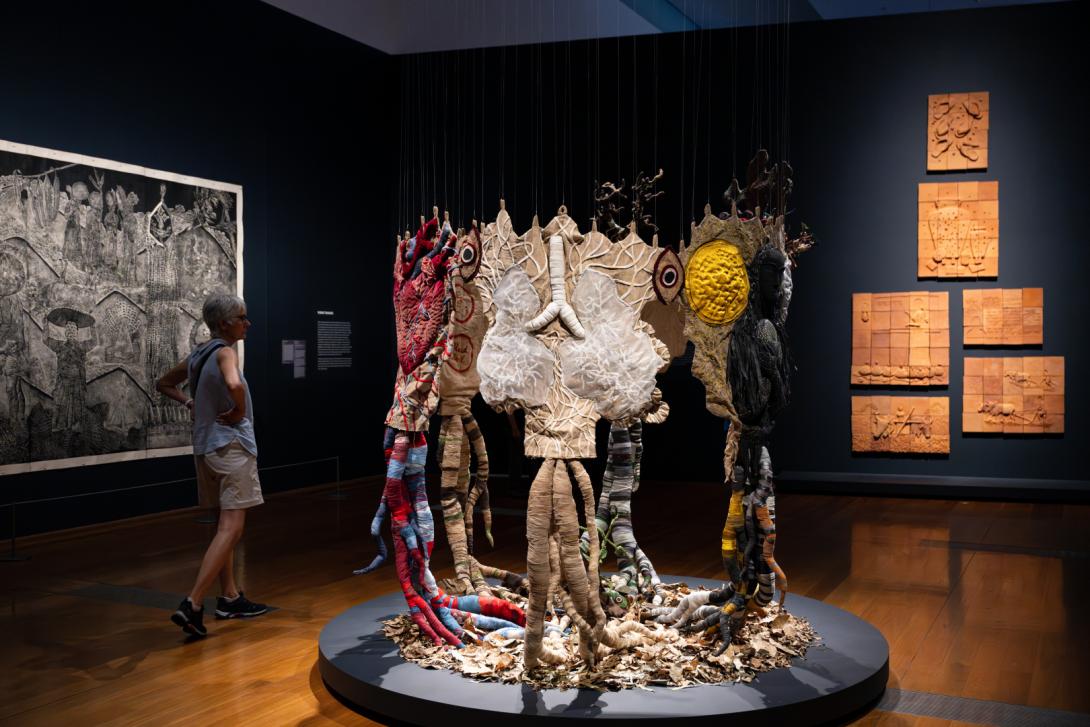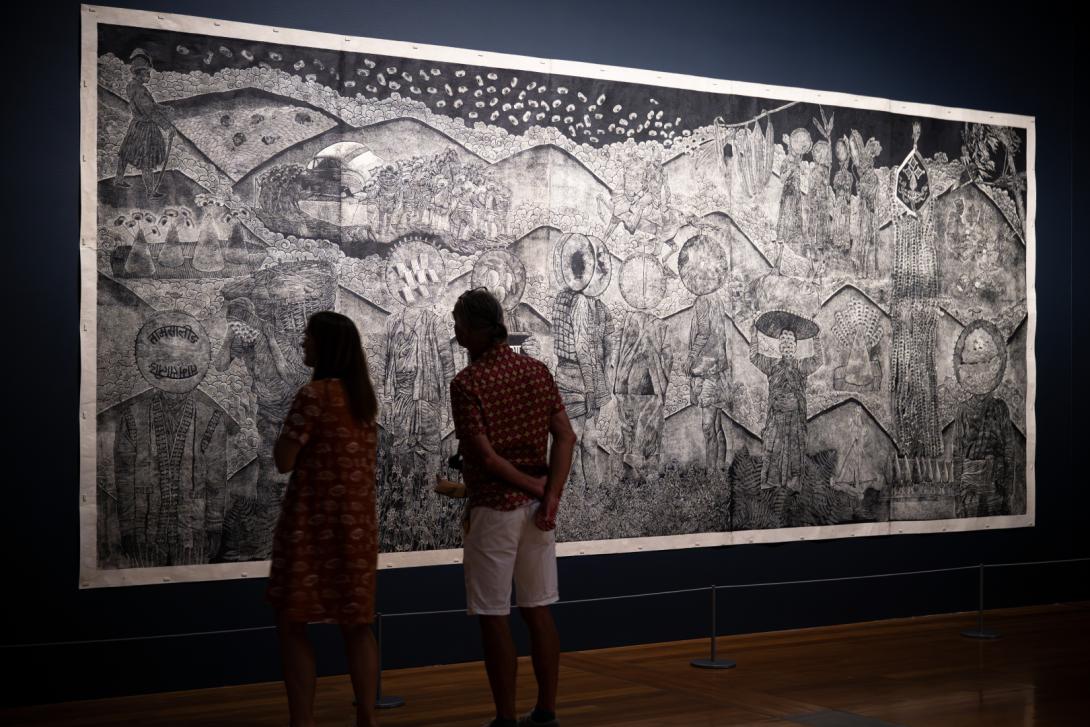TAMBA
By Tarun Nagesh
‘11th Asia Pacific Triennial’ August 2024
Nepal/India
Hit Man Gurung (Co-curator)
Sheelasha Rajbhandari (Co-curator)
Nepal and the surrounding region officially recognises 60 Indigenous nationalities as ‘Adivasi-Janajati’, which make up more than a third of the country’s total population. The wide range of distinct cultures, languages and histories of Nepal’s Indigenous people form the basis of the TAMBA project, curated by artists and co-founders of ArTree Nepal and Kalā Kulo, Hit Man Gurung and Sheelasha Rajbhandari.
In the Tamang community, oral histories concerning creation, cosmology and genealogy are narrated in songs sung by the Tambas — experts in ritual and the oral retelling of traditional history. These tales are often recounted in important ceremonies, with each sacred retelling accompanied by the rhythms of the Damphu percussion instrument. This project takes the figure of the Tamba as its entry point in order to bring together the works of Adivasi-Janajati artists, writers, poets, researchers and activists. The intervention is rooted in an intersectional history-making of Adivasi-Janajati peoples in Nepal and surrounding regions, and speaks of and against oppression, nation-states and borders through a praxis grounded in Indigenous ontology and epistemology.
TAMBA features the work of Lavkant Chaudhary, Alyen Leeachum Foning, Mekh Limbu, Keepa Maskey, Jagdish Moktan, Subas Tamang and Indu Tharu.

Work by TAMBA participants installed at GOMA for the 11th Asia Pacific Triennial, November 2024: (l–r) Subas Tamang / KAAITEN: History, Memory, Identity (detail) 2024 / Woodcut prints on Nepali handmade paper / Purchased 2024. QAGOMA Foundation; Alyen Leeachum Foning / The Story of Muun 2024 / Upcycled textiles, paper, cotton/jute/other textile chords, papiermâché, wire frame / Courtesy: The artist; and Lavkant Chaudhary (“बटिया हेरटि रहना आँखी . . .” Batiya Herati Rahana Ankhi . . . (Waiting for lost souls . . .) Reproduction of the Memorial Pillar, Kumbhar Adda Memorial Park, Semrauwa, Bardiya Nepal 2024 / Terracotta / Purchased 2024. QAGOMA Foundation / © The artists / Photograph: C Callistemon, QAGOMA
Tharu people
Born 1988, Sarlahi, Nepal
Lives and works in Kathmandu, Nepal
Lavkant Chaudhary’s “बटिया हेरटि रहना आँखी...” Batiya Herati Rahana Ankhi (Waiting for lost souls…) is a terracotta installation that eloquently narrates the oppressed history of the Tharu Indigenous people. During the ten-year conflict (1996 to 2006) in Nepal, the Tharu community bore the brunt of state-sponsored violence. Tharu individuals were often subject to suspicion merely based on their ethnicity, leading to interrogations, physical abuse and forcible arrests. Instances of disappearances and killings were also frequent.
These works are based on Lavkant’s recent commission for an on-site monument commemorating civilians subject to enforced disappearances in Bardiya District, Nepal — an area that witnessed disproportionate levels of violence during the war. The installation is an attempt to contextualise trauma and simultaneously acknowledge pain, while questioning the role of justice in such periods of violence.
Lepcha people
Born 1983, Kalimpong, India
Lives and works in Kalimpong
Alyen Leeachum Foning’s installation is dedicated to her ancestors — who originated from the snow of Khangchendzonga, the third-highest mountain in the world — and to the story of her people, who are forging their Indigenous identity in contemporary times.
Muun, the female shaman, holds histories and stories of the Indigenous Lepcha people and their landscape, and invokes the spirits of the land and their ancestors. They are the medium between the spirit world, Mother Creator and humans. Drawing upon oral histories, stories from tribal elders and Alyen’s own journey coming from a lineage of Muuns, her work details the role of Muun as healer, spiritual guide, diviner and ritual specialist that regenerates the human body, land, ancestral connection and Lepcha identity.
Yakthung people
Born 1985, Dhankuta, Nepal
Lives and works in Dhankuta and Kathmandu, Nepal
The video work Mangdem’ma and the accompanying handloom textile SAAM LINGMAA — both invocations for the healing of Adivasi spirits and lands — narrate the story of the Yakthung Indigenous people and present a counter-narrative to their record in history. The artworks weave together ancestral voices, drawing from the spiritual and cultural canon of the Yakthung people, the Mundhum.
Against a backdrop of geopolitical wreckage, the works question postcolonial nation-states and explore the mechanisms of controlling and surveilling land in contrast to Indigenous claims of space, time and mobility. Rooted in a long, rich oral tradition it incorporates elements such as bootleg audiobooks, indie albums and films, family interviews and ritual chants.
Newa people
Born 1973, Nepal
Lives and works in Kathmandu, Nepal
Keepa Maskey’s artistic journey delves into the intricate relationship between body, identity, soil and compost. Breaking away from cultural constraints, she explores diverse perspectives through experiential works that challenge conventional norms. Her paternal grandmother, Nani Maiya Maskey, played a pivotal role in this exploration, prompting her to question the intricate complexities within the existing caste system and how it shaped her identity.
At present, it is through writing, drawing, stitching, filming, deconstructing, collecting, colouring, listening, moving and performing that she connects and imagines a notion of community armoured and guided by ancestral knowledge.

Jagdish Moktan's Drifting Toward the Red Star 2022 works (Oil on canvas) and Mekh Limbu's SAAM LINGMAA – an invocation for the healing of adivasi spirits and lands 2024 (Handloom cotton), installed at GOMA for the 11th Asia Pacific Triennial, November 2024 / Purchased 2024. Queensland Art Gallery | Gallery of Modern Art Foundation / © The artists / Photograph: C Callistemon, QAGOMA
Tamang people
Born 1996, Nepal
Lives and works in Bhaktapur, Nepal
Jagdish Moktan is interested in ideas of home, belonging and liminality. In his practice, he is currently exploring the personal history of migration from village to city, interweaving narratives based on archival images, books and experiences.
‘Drifting Toward the Red Star’ is an ongoing project that explores the artist’s family history through photographs, socialist literature, communist ephemera and educational materials. Central to this exploration is his father’s journey, migrating to the city as a young boy and embracing the art of thangka painting to forge his livelihood. Acknowledging his father’s struggles, Moktan’s works bring forth moments of nostalgia, intricately woven memories and, ultimately, the profound connection between marginalised communities, the burgeoning communist movement and Indigenous activism.
Tamang people
Born 1990, Morang, Nepal
Lives and works in Kathmandu, Nepal
During the 19th century in Nepal, the Tamang people endured extensive labour servitude, where they were coerced into providing corvée labour to the state and its representatives. The rulers justified these atrocities by classifying the Tamangs as ‘masinya matwali’, a legally enslavable, alcohol-drinking group. Consequently, this form of slavery led to the degradation of the Tamangs’ situation for generations, pushing many families into extreme poverty. Subas’s large woodcut prints serve as a poignant reminder of those painful historical events.
For the Asia Pacific Triennial, Subas presents the animation Tamba, based on the Tamba Whyai of creation as sung by Dhawa Wangel Moktan. This work details the Tamang song of origin that recounts the process of life within each cycle of creation. Poetry, history and ritual intersect in this video, while visually recounting stories passed down from Tamang elders.
Tharu people
Born 1989, Nepal
Lives and works in Kailali, Nepal
Tharu women have made significant contributions to the struggle for Indigenous rights and recognition in Nepal. Artist, writer and activist Indu Tharu documents the participation and leadership of women in strengthening the movement through her work titled Ragat Timro Pani Raato Chha (Your Blood Runs Red Too).
Alongside a poem are a collection of photos taken by Tharu, as well as those she has collected from other activists that show key moments of activism from 2012 onwards. These works explore the systemic culture of exclusion, oppression and violence facing the Tharu community within the Nepali state.

Subas Tamang's KAAITEN: History, Memory, Identity (detail) 2024, installed at GOMA for the 11th Asia Pacific Triennial, November 2024 / Woodcut prints on Nepali handmade paper / Purchased 2024. QAGOMA Foundation / © Subas Tamang / Photograph: C Callistemon, QAGOMA



